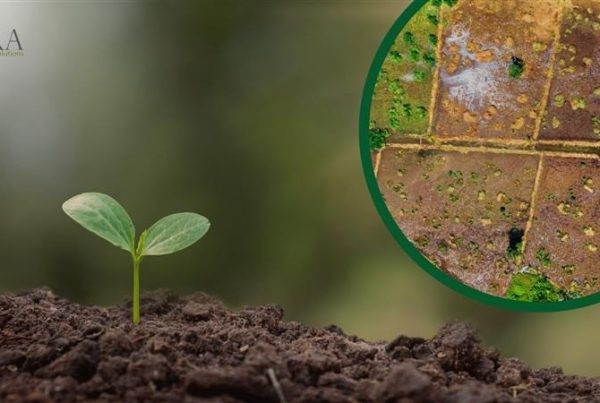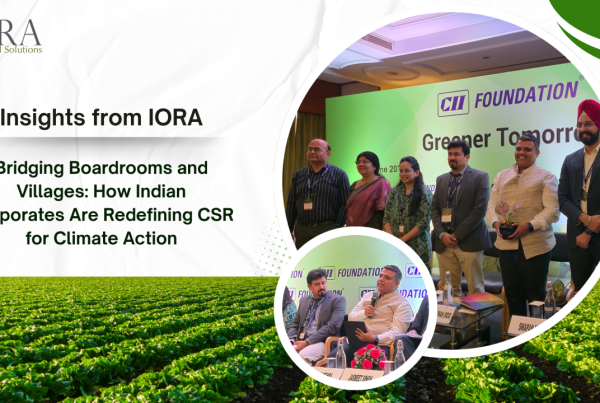As Bengaluru stares at its worst water crisis in decades, it raises an often-discussed question – how do we envision the growth and sustainability of our burgeoning cities?
The uncompromising demand of Indian urban centres for resources has simultaneously side-lined the natural ecosystems that provide these resources. Occurrences of flash flooding and stormwater runoff rise with the increasing expansion of concretised, impervious surfaces. The nexus of urban heat island effect and heatwaves posing serious health concerns has become a regular phenomenon. With more extreme rainfall and temperature patterns, and without significant nature-based urban adaptation, the frequency of such occurrences seems only to rise. Strengthening natural ecosystems present in the cities becomes an obvious way to go. Urban forests in Seoul have been found to have temperatures lower than the surrounding grey infrastructure by 1.1°C.[1] Omotoye et al. (2022) note that urban forests can induce improvements in cardiovascular health, and have favourable impact on mental health as well.[2]
Unlike forest lands that are managed by state forest departments with demarcated roles and responsibilities, urban green cover in India is managed by a plethora of municipal departments and institutions, who often work in silos. This can often make it challenging for the public to hold these public institutions accountable in protecting and enhancing urban green cover.[3] There is also a dearth of understanding among planning departments of the ecosystem services urban forests provide. Such knowledge gaps go into decision-making, preventing planners from harnessing the strength of forests and nature-based solutions.
Contextually designed and planned urban forests act as green infrastructure, bringing in much-required respite from heat island effects via evapotranspirational cooling.[4] With high air pollution levels becoming a characteristic of urban centres, particularly in the Indo-Gangetic region, urban forests can also act as filters for pollutants and dust. They strengthen soil systems which, in turn, play a crucial role in tackling the nutrient pollution concentrations in catchment run-off.[5] They provide habitat for plant and animal biodiversity which form complex systems that maintain the environmental ecosystems of urban centres. Perhaps, urban forests are one of the most cost-efficient and effective methods for climate adaptation in cities.
It is also necessary to understand who gets to access the existing green cover in cities and towns, and if the ecosystem services are equitably distributed. As Schwarz et al. (2015) noted, “Money may not grow on trees, but… trees grow on money.”[6] A study analysed location of green spaces in cross Delhi and found it to be skewed towards high-income neighbourhoods.[7] This highlights that lower-income, marginalised groups receive lesser environmental services while having higher climate-related vulnerabilities and lower access to other modes of comfort. Access to recreational ecosystem services, such as walking into a well-maintained garden or simply residing in the vicinity of green spaces, is a privilege not all residents across many Indian urban centres enjoy. [8] [9] Aligning urban climatic adaptation and environmental justice can be challenging, as small and scattered green spaces tend to not be as effective as fewer and larger urban forests.[10] Additionally, these larger areas are shared more equitably, rather than smaller areas often present in high income neighbourhoods. This brings to call the key roles of urban planners, developers, researchers, and decision-makers, in innovating and designing urban forests, presence of which can be enjoyed by all communities and social groups.
The nexus between the urban forest and the anticipated long-term nature of the catchments is central to forest management. To address public health challenges such as allergens and heat exposure, collaboration among climatologists, public health professionals, forest scientists and managers, is imperative. Additionally, planning will require not just aligning the physiography of the urban centre with the plant species, but also understanding how the biodiversity can contribute to tackling contextual urban problems. For example, an urban forest can help regulate air pollution, but certain tree species emit biogenic volatile organic compounds (BVOCs), which under suitable conditions can aid in smog formation. Though the research on this is still inconclusive, it has been seen in some Mediterranean cities that see intense summers.[11] [12] Species selection must also look beyond high carbon stocks and fast-growing species, a common phenomenon in climate mitigation interventions. Species native to the region tend to maintain the water table and soil health better than non-native trees, especially when adequate watering and general care are provided in the initial years.
Few examples exist within India that have realised the potency of urban forestry and harnessed it. Kerwa forest area in Bhopal was chosen to be rejuvenated in 2008 by the state forest department. Ecological health of Kerwa is directly related to maintaining the catchment area of the lake that supplies 40% of the water to the city. With plantation of 22 tree and five herb species, the forest is now a hub for in situ conservation.[13] Urban forest in Nagpur and Warje forest in Pune are also notable interventions.
Nonetheless, establishing a high tree stem-density forest in populated cities, while ensuring equitable usage of its services is difficult. Such land-use decisions require support of the government. The Government of India announced in 2016 to develop 200 urban forests in five years. The initiative was re-launched in 2020 under the banner of the Nagar Van Yojana, envisaging the creation of 1,000 urban forests or green spaces. By August 2023, 385 projects had been sanctioned (Press Information Bureau, 2023),[14] with Telangana, Odisha, and Jharkhand having the most approved projects. The materialisation of these sanctioned projects will be a boon for these cities and the health of its inhabitants.
The celebration of International Day of Forests, 2024 calls for innovation in our being with forests. Let us innovatively forge the future of our towns and cities where environmental health is a primary agenda and ecosystems’ services are equitably benefitted.
[1] Hwang, B., Sou, H.-D., Oh, J.-H., & Park, C.-R. (2023). Cooling effect of urban forests on the urban heat island in Seoul, South Korea. PLOS ONE, 18(7), e0288774. https://doi.org/10.1371/journal.pone.0288774
[2] Omotoye, O. T., Aduwo, E. B., Okunlola, P. O., & Anjorin, T. O. (2022). Urban Forestry and Its Impact on the Health of Residents of Covenant University, Ota, Ogun State. IOP Conference Series: Earth and Environmental Science, 1054(1), 012036. https://doi.org/10.1088/1755-1315/1054/1/012036
[3] Kohli, K., & Menon, M. (2022). Regulating Urban Trees in India | Heinrich Böll Stiftung | India Office. https://in.boell.org/en/urban-trees-india
[4] Norton, B. A., Coutts, A. M., Livesley, S. J., Harris, R. J., Hunter, A. M., & Williams, N. S. G. (2015). Planning for cooler cities: A framework to prioritise green infrastructure to mitigate high temperatures in urban landscapes. Landscape and Urban Planning, 134, 127–138. https://doi.org/10.1016/j.landurbplan.2014.10.018
[5] Livesley, S. J., McPherson, E. G., & Calfapietra, C. (2016). The Urban Forest and Ecosystem Services: Impacts on Urban Water, Heat, and Pollution Cycles at the Tree, Street, and City Scale. Journal of Environmental Quality, 45(1), 119–124. https://doi.org/10.2134/jeq2015.11.0567
[6] Schwarz, K., Fragkias, M., Boone, C. G., Zhou, W., McHale, M., Grove, J. M., O’Neil-Dunne, J., McFadden, J. P., Buckley, G. L., Childers, D., Ogden, L., Pincetl, S., Pataki, D., Whitmer, A., & Cadenasso, M. L. (2015). Trees Grow on Money: Urban Tree Canopy Cover and Environmental Justice. PLOS ONE, 10(4), e0122051. https://doi.org/10.1371/journal.pone.0122051
[7] Mitchell, B. C., Chakraborty, J., & Basu, P. (2021). Social Inequities in Urban Heat and Greenspace: Analyzing Climate Justice in Delhi, India. International Journal of Environmental Research and Public Health, 18(9), 4800. https://doi.org/10.3390/ijerph18094800
[8] Chandrashekhar, V. (2019, June 20). Mumbai’s richer areas get more access to green spaces, finds IIT Bombay study. The Times of India. https://timesofindia.indiatimes.com/city/mumbai/mumbais-richer-areas-get-more-access-to-green-spaces-finds-iit-bombay-study/articleshow/69866779.cms
[9] Bhandari, L. (2016, October 21). Inequality of urban green spaces. https://www.business-standard.com/article/economy-policy/inequality-of-urban-green-spaces-116102100015_1.html
[10] Jaganmohan, M., Knapp, S., Buchmann, C. M., & Schwarz, N. (2016). The Bigger, the Better? The Influence of Urban Green Space Design on Cooling Effects for Residential Areas. Journal of Environmental Quality, 45(1), 134–145. https://doi.org/10.2134/jeq2015.01.0062
[11] Calfapietra, C., Fares, S., Manes, F., Morani, A., Sgrigna, G., & Loreto, F. (2013). Role of Biogenic Volatile Organic Compounds (BVOC) emitted by urban trees on ozone concentration in cities: A review. Environmental Pollution, 183, 71–80. https://doi.org/10.1016/j.envpol.2013.03.012
[12] Tyrväinen, L., Pauleit, S., Seeland, K., & De Vries, S. (2005). Benefits and Uses of Urban Forests and Trees. In C. Konijnendijk, K. Nilsson, T. Randrup, & J. Schipperijn (Eds.), Urban Forests and Trees (pp. 81–114). Springer Berlin Heidelberg. https://doi.org/10.1007/3-540-27684-X_5
[13] Dwivedi, P., Rathore, C. S., & Dubey, Y. (2009). Ecological benefits of urban forestry: The case of Kerwa Forest Area (KFA), Bhopal, India. Applied Geography, 29(2), 194–200. https://doi.org/10.1016/j.apgeog.2008.08.008
[14] https://pib.gov.in/PressReleaseIframePage.aspx?PRID=1946406






